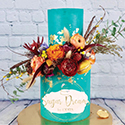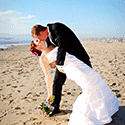A while back we shared the history of the white wedding dress, introduced by Queen Victoria on her big day back in 1840. Ever wonder why there’s a best man, or who wore the first wedding veil? According to Tricia Spencer, author of “1001 Wedding Ideas: The Ultimate Resource for Creating a Wedding No One Will Ever Forget,” many of those common customs have less than auspicious origins. Here are a few:

Photo courtesy of Sharpe Photographers. To see more of Kelly Amber and Tom’s wedding, click here!
The Bridal Veil – ‘Til Death Do Us Part
The bridal veil is a beautiful accent to a bride’s wedding day ensemble. Veils can be of any length, plainly made or exquisitely adorned, and be worn over the face or not. Such aesthetic freedom wasn’t always the case.
In ancient Rome, brides approached their intendeds in a veil that covered them from head to foot. There was so much fabric that some grooms probably wondered if their brides were even “in there”. But brides weren’t hiding. They were thinking ahead…to their deaths. A bridal veil was fashioned to match the height of a bride so that it could later be used as her burial shroud. It may sound morbid, but perhaps ancient brides were simply ingenious fore-mothers of recycling.
In other bygone cultures, brides did go to their grooms with secrecy in mind. Heavy veils concealed the faces of brides whom grooms had never seen. Arranged marriages were prevalent back in the day, and the groom’s first glimpse of his new wife was when the officiant declared them married. It was a practice that likely generated plenty of shock and awe at the altar.

Photo courtesy of True Love Photo. To see more of Jessica and PJ’s wedding, click here!
The Best Man – He’s Got Your Back
The best man at a modern wedding has plenty of responsibilities, like toasting the bride and groom, spearheading the bachelor party, guarding the rings and assuring that the groom is on time for his nuptials. It sounds like a lot of responsibility, until his duties are compared to the best man’s obligations of long ago eras. Those judiciously chosen “best men” of yore were called upon to do more than provide a supportive presence. They were expected to help to steal the bride.
Some villages had a significant shortage of women, so a man looking to marry enlisted the aid of his best friend to go on a bride-napping field trip. A female-flush village down the road was a fertile place to wife shop. Unfortunately the poor unsuspecting bride-to-be was denied any wining, dining or wooing during the process. She was simply taken.
The captive bride’s loved ones understandably frowned upon this “courtship” and would mount an offensive to reclaim her, an effort that provided a stellar opportunity for the best man to show his stalwart commitment. He stood next to the groom at the wedding to protect the stolen bride from being stolen back. A completed marriage ceremony forever sealed the bride’s fate, so the actual wedding was the last opportunity for her family to attempt a rescue.
Both the groom and his best man adopted a defensive stance to insure that there would be no restrictions or encumbrances of their right hands and their weapons. Once the bride was in the groom’s possession, she was his, period, so he wasn’t about to let her be snatched from him before the deed was done. The best man honored the groom by putting his own life on the line to make sure no re-stealing of the stolen bride would happen on his watch.
Grooms don’t get to steal their brides today, but the best man still stands to the groom’s right, even if only to prove his friendship and not his battle readiness.
Today’s best man may be a fun-loving friend, but his position was born because he was first a warrior.

Photo courtesy of The Goodness. To see more of Lisa and Nolan’s wedding, click here!
Wedding Car Shoes – Dunk!
A wedding car pulling away with bumper-tied shoes dancing in its wake is the iconic image of a bride and groom’s getaway from the wedding. Spirited, bouncing shoes seems like such innocent, whimsical fun. But are they?
The bride’s shoes were once symbolic of possession and authority — not the bride’s, her father’s. The shoe ritual may have begun in ancient Egypt as a sign of transference of power. The father of the bride removed the bride’s wedding sandals and gave them to the groom. The groom would complete the “power” ritual by using one of the shoes to tap his new bride on the head, signifying his acquired position as her new master. Bruise or no bruise, the father then had no more authority to “guide” and “discipline” his daughter. Those tasks became the responsibility of the bride’s new husband, the wielder of the shoe.
In later Tudor cultures, shoes were thrown at the bride and groom as a gesture of good luck as the couple departed the wedding. Symbolically, one can hope that shoes tied to the backsides of modern wedding cars are an evolution of the later shoe-throwing good wishes and not descended from the shoe-to-head power tap.
Blog post by Real Weddings Magazine’s Always a Bridesmaid Columnist, Darren Elms.
Subscribe to the Real Weddings Magazine Blog! Click here: [subscribe2]

































































